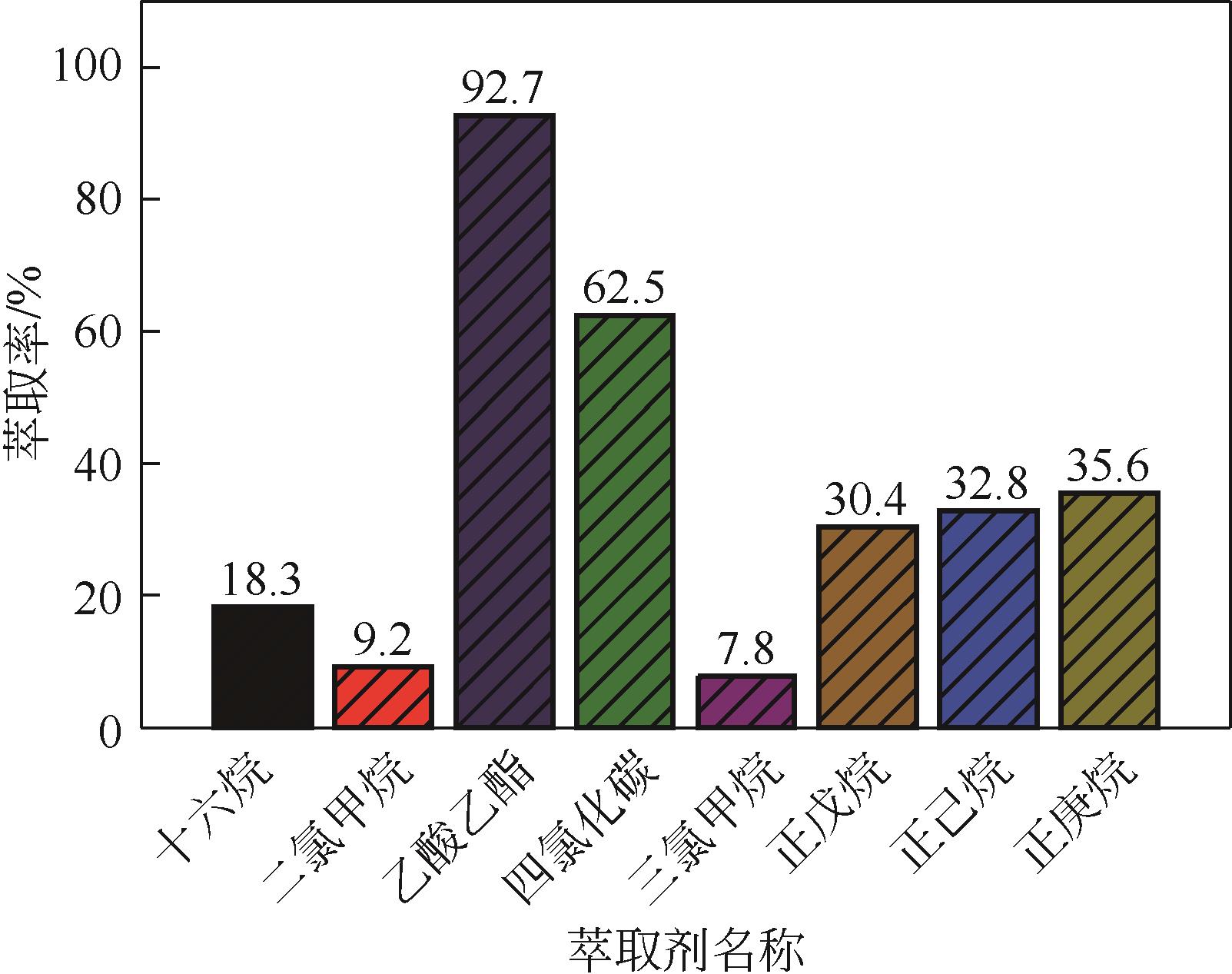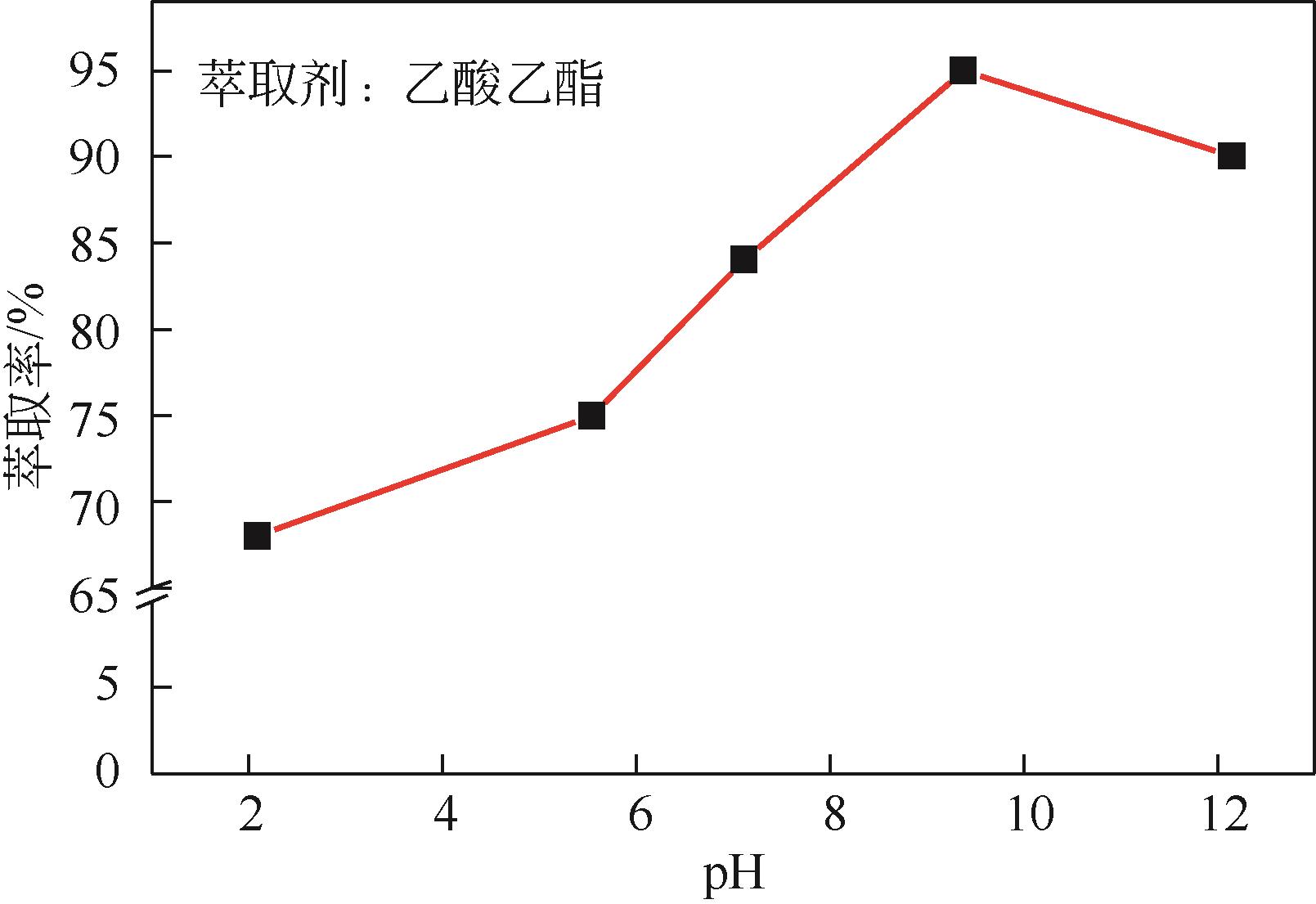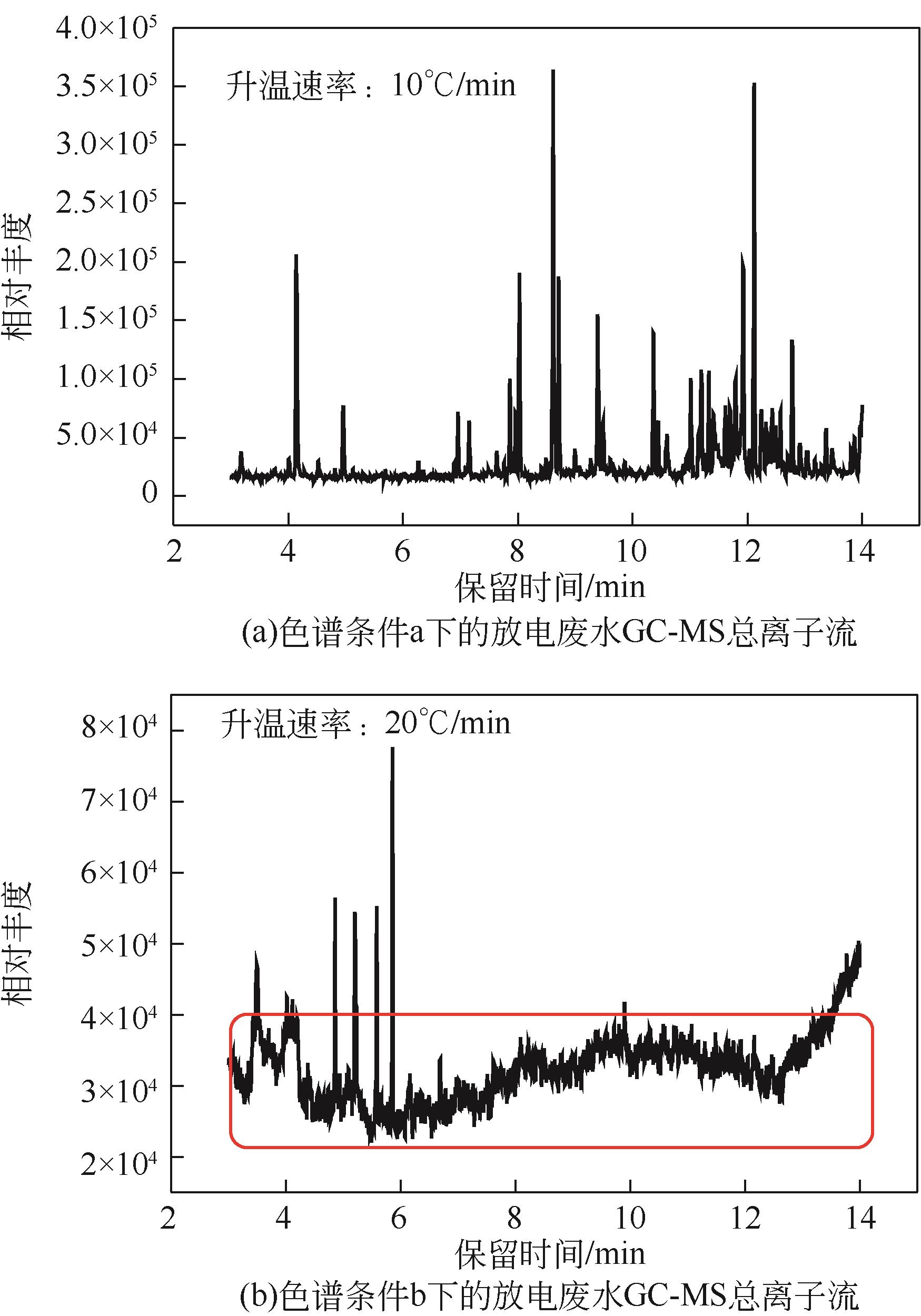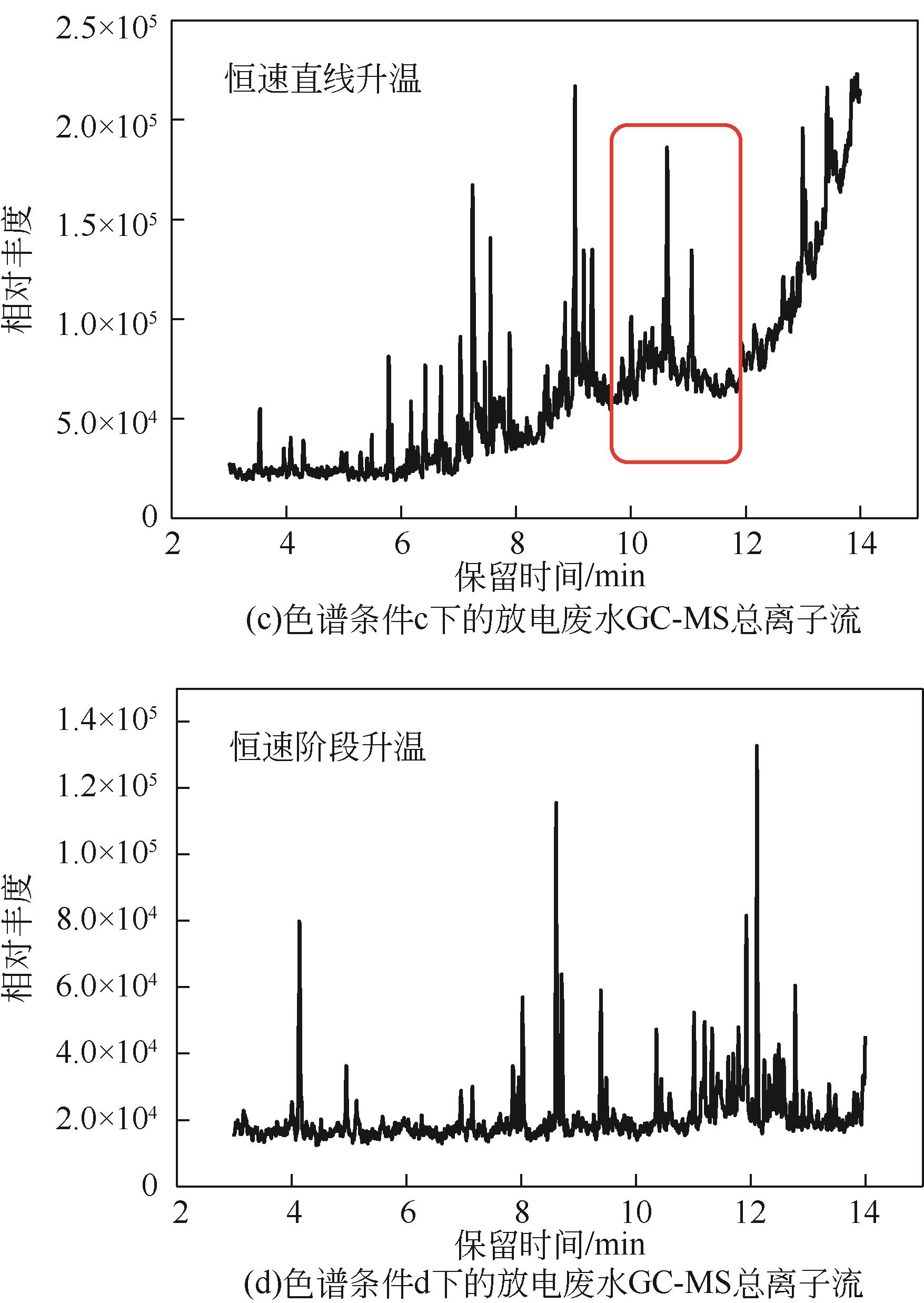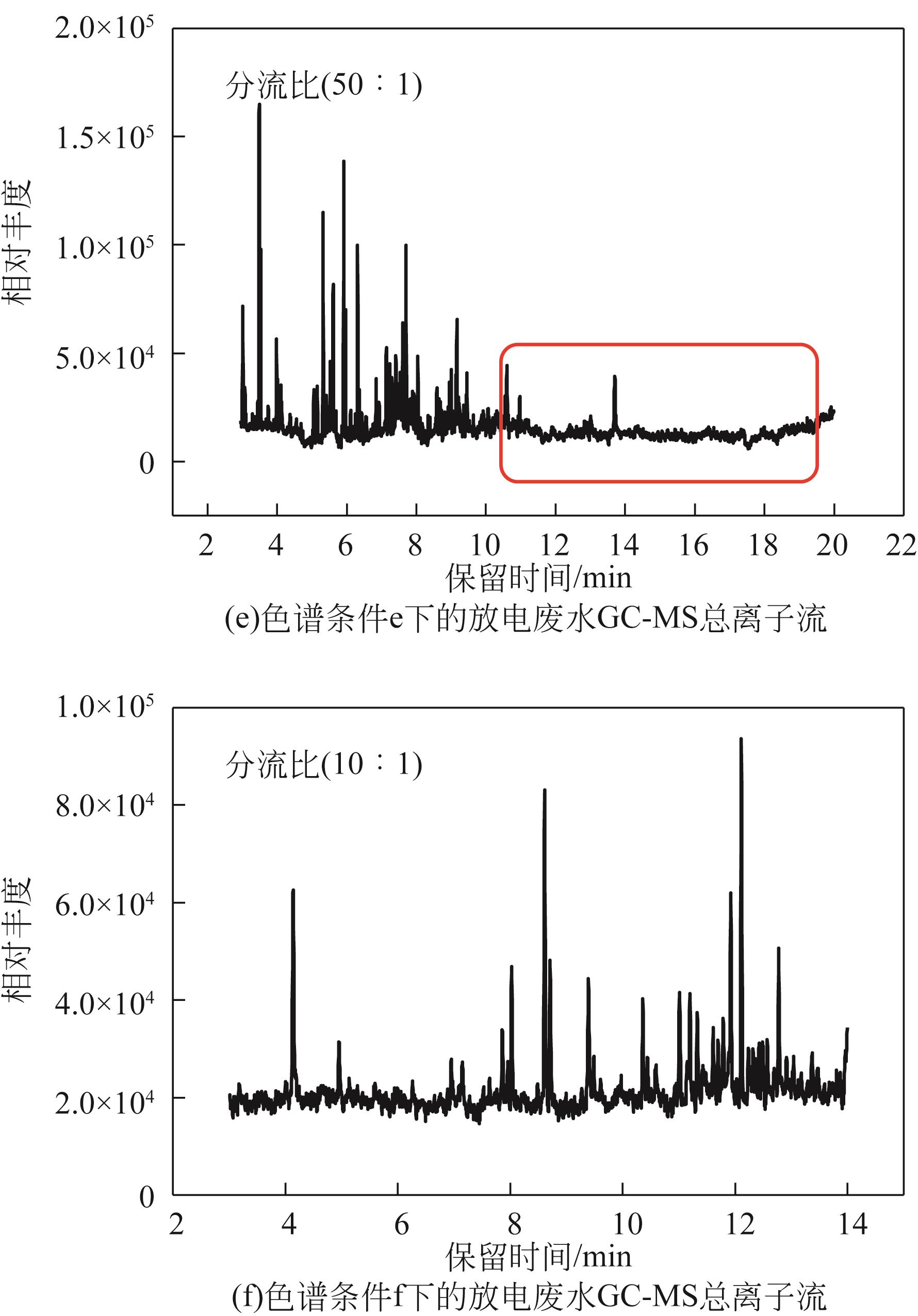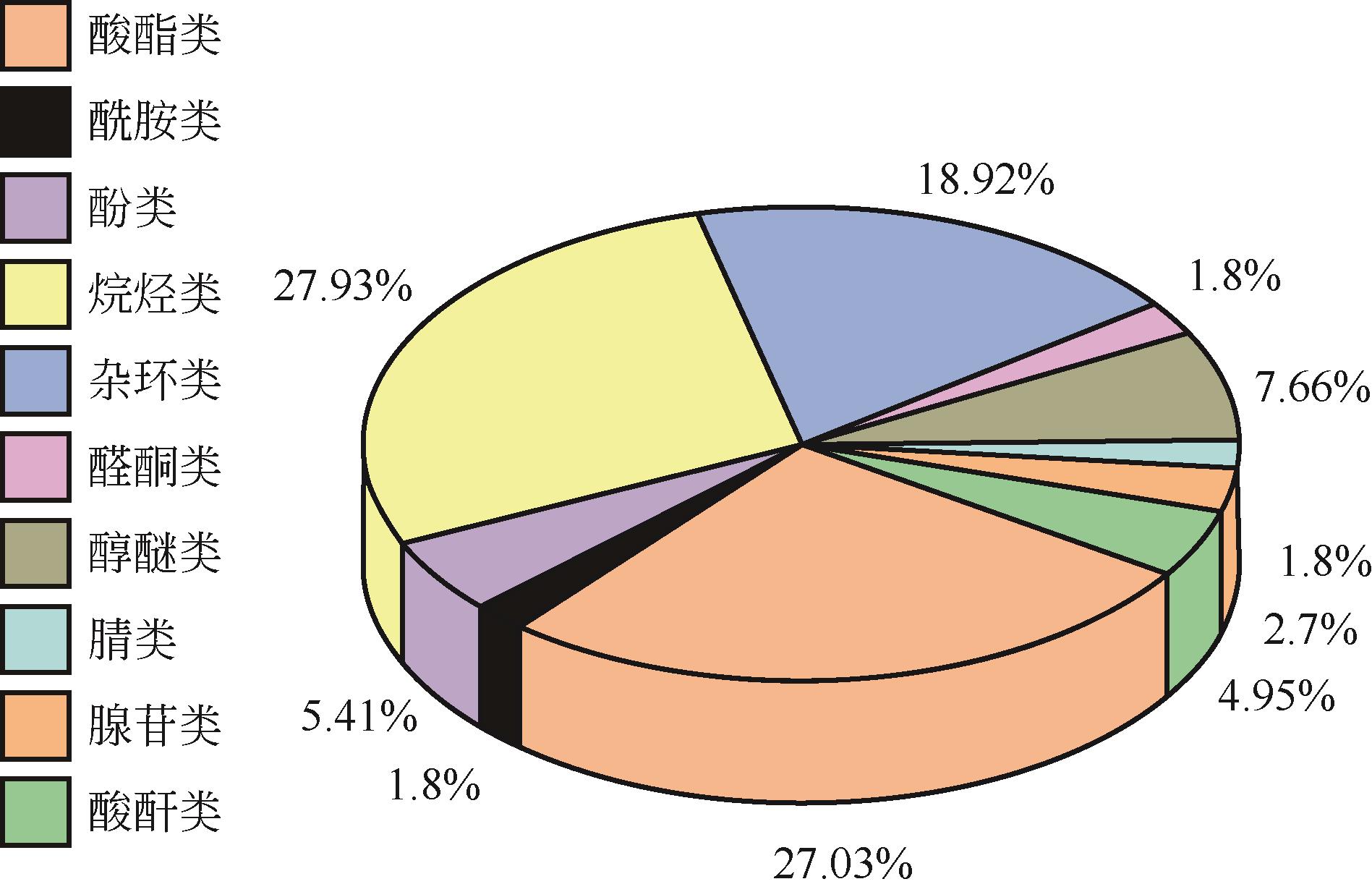化工进展 ›› 2022, Vol. 41 ›› Issue (10): 5619-5629.DOI: 10.16085/j.issn.1000-6613.2021-2486
退役锂电池放电废水特征有机污染物解析
- 1.上海第二工业大学资源与环境工程学院,上海电子废弃物资源化协同创新中心,上海 201209
2.中国科学院 过程工程研究所环境技术与工程研究部,绿色过程与工程重点实验室,北京市过程污染控制工程技术研究中心,北京 100190
-
收稿日期:2021-12-03修回日期:2022-04-26出版日期:2022-10-20发布日期:2022-10-21 -
通讯作者:张西华,熊梅 -
作者简介:刘肖贝(1997—),女,硕士研究生,研究方向为退役锂电池放电废水特征污染物筛查。E-mail:1031489122@qq.com。 -
基金资助:上海市高原学科——环境科学与工程(资源循环科学与工程)资助项目;中国科学院重点部署项目(ZDRW_CN_2020-1)
Analysis on the characteristic organic pollutants from discharge wastewater of spent lithium batteries
LIU Xiaobei1,2( ), ZHANG Xihua1(
), ZHANG Xihua1( ), XIONG Mei2(
), XIONG Mei2( ), ZHAO He2
), ZHAO He2
- 1.School of Resources and Environmental Engineering, Shanghai Polytechnic University, Shanghai Collaborative Innovation Center for WEEE Recycling, Shanghai 201209, China
2.Beijing Engineering Research Center of Process Pollution Control, Key Laboratory of Green Process and Engineering, Division of Environment Technology and Engineering, Institute of Process Engineering, Chinese Academy of Sciences, Beijing 100190, China
-
Received:2021-12-03Revised:2022-04-26Online:2022-10-20Published:2022-10-21 -
Contact:ZHANG Xihua, XIONG Mei
摘要:
为研究退役锂电池盐水溶液放电产生的放电废水有机物的种类与来源,首先采用单因素优化方法对萃取剂类型、pH、萃取次数3个因素进行液-液萃取前处理优化实验,获得最佳萃取预处理条件。接着采用气相色谱与质谱联用(GC-MS)程序中分流比和升温模式对比实验,建立了放电废水有机成分定性分析方法,并对检出的有机污染物进行分类与来源判断。研究结果表明,选取乙酸乙酯为萃取剂,调节放电废水pH至9.38,以8000 r/min离心5min(4℃),且采用间歇三次萃取时分离效果最优。对放电废水SIM定性扫描检测出10类有机污染物,其中酸酯类、酰胺类、烷烃类物质较多,且来源于反应衍生物与电解液添加剂的占比较大,分别为33.3%与20%,包括电解质增塑剂间苯二甲酸二(2-乙基己基)酯,电解液溶剂效应产物1,4-环己烷二羧酸二甲酯、磷酸 三(2-氯乙基)酯,电解液添加剂硬脂酰胺、十六碳酰胺、十四酰胺、1,4-环己烷二甲醇二乙烯醚,退役锂电池塑料外壳中抗氧剂原料3,5-二叔丁基苯酚等。这些物质对水环境均具有不同程度的毒性危害,需进一步检测各有机物浓度并揭示其迁移转化规律,建立退役锂电池放电废水重点关注有机污染物清单。
中图分类号:
引用本文
刘肖贝, 张西华, 熊梅, 赵赫. 退役锂电池放电废水特征有机污染物解析[J]. 化工进展, 2022, 41(10): 5619-5629.
LIU Xiaobei, ZHANG Xihua, XIONG Mei, ZHAO He. Analysis on the characteristic organic pollutants from discharge wastewater of spent lithium batteries[J]. Chemical Industry and Engineering Progress, 2022, 41(10): 5619-5629.
| 单因素优化项目 | 萃取剂名称 | pH | 萃取次数 |
|---|---|---|---|
| 方案1 | 十六烷 | 2.09 | 1 |
| 方案2 | 二氯甲烷、三氯甲烷 | 5.54 | 2 |
| 方案3 | 四氯化碳 | 7.12 | 3 |
| 方案4 | 乙酸乙酯 | 9.38 | 4 |
| 方案5 | 正戊烷、正己烷、正庚烷 | 12.15 | 5 |
表1 放电废水GC-MS萃取条件优化方案设计
| 单因素优化项目 | 萃取剂名称 | pH | 萃取次数 |
|---|---|---|---|
| 方案1 | 十六烷 | 2.09 | 1 |
| 方案2 | 二氯甲烷、三氯甲烷 | 5.54 | 2 |
| 方案3 | 四氯化碳 | 7.12 | 3 |
| 方案4 | 乙酸乙酯 | 9.38 | 4 |
| 方案5 | 正戊烷、正己烷、正庚烷 | 12.15 | 5 |
| 序号 | 类别 | 有机物名称 | 分子式 | 分子量 | CAS# | 峰面积百分比/% | 匹配度/% |
|---|---|---|---|---|---|---|---|
| 1 | 酸酯类 | 间苯二甲酸二(2-乙基己基)酯 | C24H38O4 | 390.5561 | 137-89-3 | 3.47 | 92 |
| 2 | 三(2,4-二叔丁基)亚磷酸苯酯 | C42H63O3P | 646.92 | 31570-4-4 | 3.22 | 89 | |
| 3 | 碳酸乙烯酯 | C3H4O3 | 88.06 | 96-49-1 | 0.87 | 89 | |
| 4 | 3-甲基丁酸1,7,7-三甲基二环[2.2.1]庚-2-基酯 | C15H26O2 | 238 | 0-0-0 | 0.71 | 90 | |
| 5 | 1,4-环己烷二羧酸二甲酯 | C10H16O4 | 200 | 19550-59-5 | 0.54 | 85 | |
| 6 | 磷酸三(2-氯乙基)酯 | C6H12Cl3O4P | 285.49 | 115-96-8 | 0.24 | 87 | |
| 7 | 十四酸乙酯 | C16H32O2 | 256.42 | 124-06-1 | 0.21 | 95 | |
| 8 | 酰胺类 | 硬脂酰胺 | C18H37NO | 283.49 | 124-26-5 | 5.84 | 95 |
| 9 | 十六碳酰胺 | C16H33NO | 255.4393 | 629-54-9 | 3.51 | 95 | |
| 10 | 十四酰胺 | C14H29NO | 227.3862 | 638-58-4 | 1.22 | 94 | |
| 11 | 酚类 | 3,5-二叔丁基苯酚 | C14H22O | 206.3239 | 1138-52-9 | 0.29 | 83 |
| 12 | 烷烃类 | 十五烷 | C15H32 | 212.4146 | 629-62-9 | 17.11 | 95 |
| 13 | 十一烷 | C11H24 | 156.31 | 1120-21-4 | 12.23 | 88 | |
| 14 | 3-乙基-3-甲基庚烷 | C10H22 | 142.2817 | 17302-1-1 | 0.40 | 91 | |
| 15 | 杂环类 | (Z)-9-十八烯腈 | C18H33N | 263.4613 | 112-91-4 | 2.20 | 85 |
| 16 | 二环己基碳二亚胺 | C13H22N2 | 222 | 53508-12-6 | 0.40 | 88 | |
| 17 | 2-溴十四烷 | C8H17Br | 193.125 | 999-6-4 | 0.14 | 70 | |
| 18 | 溴代三十烷 | C30H61Br | 501.7093 | 4209-22-7 | 0.13 | 75 | |
| 19 | 醛酮类 | 2,6-二甲基-5-庚烯醛 | C9H16O | 140 | 32160-45-5 | 0.58 | 67 |
| 20 | 4-(4'-羟基-4'-甲基戊基)-3-环己烯-1-甲醛 | C13H22O2 | 210 | 21720-87-6 | 0.28 | 69 | |
| 21 | 壬醛 | C9H18O | 142.24 | 124-19-6 | 0.26 | 82 | |
| 22 | 醇醚类 | 二丁醚 | C8H18O | 130.23 | 142-96-1 | 3.75 | 97 |
| 23 | 2,5-双(1,1-二甲基丙基)-1,4-苯二醇 | C16H26O2 | 250 | 452049-69-3 | 1.45 | 75 | |
| 24 | 二乙二醇单[(1,1,3,3-四甲基丁基)苯基]醚 | C18H30O3 | 294 | 13804-51-8 | 0.77 | 83 | |
| 25 | 1,4-环己烷二甲醇二乙烯醚 | C12H20O2 | 196 | 17351-75-6 | 0.70 | 61 | |
| 26 | 3-(5,5,6-三甲基双环(2.2.1)庚-2-基)环己-1-醇 | C16H28O | 236 | 102572-89-4 | 0.51 | 75 | |
| 27 | 腈类 | 丁二腈 | C4H4N2 | 80.09 | 110-61-2 | 4.76 | 96 |
| 28 | 5-氟-2-硝基苯乙腈 | C8H5FN2O2 | 180.14 | 3456-75-5 | 0.46 | 71 | |
| 29 | 腺苷类 | 2-羟基腺苷 | C10H13N5O5 | 283.2407 | 1818-71-9 | 0.74 | 62 |
| 30 | 酸酐类 | 异十八烷基琥珀酸酐 | C22H40O3 | 352 | 40924-19-4 | 0.25 | 76 |
表2 饱和NaCl条件下退役锂电池放电废水GC-MS结果
| 序号 | 类别 | 有机物名称 | 分子式 | 分子量 | CAS# | 峰面积百分比/% | 匹配度/% |
|---|---|---|---|---|---|---|---|
| 1 | 酸酯类 | 间苯二甲酸二(2-乙基己基)酯 | C24H38O4 | 390.5561 | 137-89-3 | 3.47 | 92 |
| 2 | 三(2,4-二叔丁基)亚磷酸苯酯 | C42H63O3P | 646.92 | 31570-4-4 | 3.22 | 89 | |
| 3 | 碳酸乙烯酯 | C3H4O3 | 88.06 | 96-49-1 | 0.87 | 89 | |
| 4 | 3-甲基丁酸1,7,7-三甲基二环[2.2.1]庚-2-基酯 | C15H26O2 | 238 | 0-0-0 | 0.71 | 90 | |
| 5 | 1,4-环己烷二羧酸二甲酯 | C10H16O4 | 200 | 19550-59-5 | 0.54 | 85 | |
| 6 | 磷酸三(2-氯乙基)酯 | C6H12Cl3O4P | 285.49 | 115-96-8 | 0.24 | 87 | |
| 7 | 十四酸乙酯 | C16H32O2 | 256.42 | 124-06-1 | 0.21 | 95 | |
| 8 | 酰胺类 | 硬脂酰胺 | C18H37NO | 283.49 | 124-26-5 | 5.84 | 95 |
| 9 | 十六碳酰胺 | C16H33NO | 255.4393 | 629-54-9 | 3.51 | 95 | |
| 10 | 十四酰胺 | C14H29NO | 227.3862 | 638-58-4 | 1.22 | 94 | |
| 11 | 酚类 | 3,5-二叔丁基苯酚 | C14H22O | 206.3239 | 1138-52-9 | 0.29 | 83 |
| 12 | 烷烃类 | 十五烷 | C15H32 | 212.4146 | 629-62-9 | 17.11 | 95 |
| 13 | 十一烷 | C11H24 | 156.31 | 1120-21-4 | 12.23 | 88 | |
| 14 | 3-乙基-3-甲基庚烷 | C10H22 | 142.2817 | 17302-1-1 | 0.40 | 91 | |
| 15 | 杂环类 | (Z)-9-十八烯腈 | C18H33N | 263.4613 | 112-91-4 | 2.20 | 85 |
| 16 | 二环己基碳二亚胺 | C13H22N2 | 222 | 53508-12-6 | 0.40 | 88 | |
| 17 | 2-溴十四烷 | C8H17Br | 193.125 | 999-6-4 | 0.14 | 70 | |
| 18 | 溴代三十烷 | C30H61Br | 501.7093 | 4209-22-7 | 0.13 | 75 | |
| 19 | 醛酮类 | 2,6-二甲基-5-庚烯醛 | C9H16O | 140 | 32160-45-5 | 0.58 | 67 |
| 20 | 4-(4'-羟基-4'-甲基戊基)-3-环己烯-1-甲醛 | C13H22O2 | 210 | 21720-87-6 | 0.28 | 69 | |
| 21 | 壬醛 | C9H18O | 142.24 | 124-19-6 | 0.26 | 82 | |
| 22 | 醇醚类 | 二丁醚 | C8H18O | 130.23 | 142-96-1 | 3.75 | 97 |
| 23 | 2,5-双(1,1-二甲基丙基)-1,4-苯二醇 | C16H26O2 | 250 | 452049-69-3 | 1.45 | 75 | |
| 24 | 二乙二醇单[(1,1,3,3-四甲基丁基)苯基]醚 | C18H30O3 | 294 | 13804-51-8 | 0.77 | 83 | |
| 25 | 1,4-环己烷二甲醇二乙烯醚 | C12H20O2 | 196 | 17351-75-6 | 0.70 | 61 | |
| 26 | 3-(5,5,6-三甲基双环(2.2.1)庚-2-基)环己-1-醇 | C16H28O | 236 | 102572-89-4 | 0.51 | 75 | |
| 27 | 腈类 | 丁二腈 | C4H4N2 | 80.09 | 110-61-2 | 4.76 | 96 |
| 28 | 5-氟-2-硝基苯乙腈 | C8H5FN2O2 | 180.14 | 3456-75-5 | 0.46 | 71 | |
| 29 | 腺苷类 | 2-羟基腺苷 | C10H13N5O5 | 283.2407 | 1818-71-9 | 0.74 | 62 |
| 30 | 酸酐类 | 异十八烷基琥珀酸酐 | C22H40O3 | 352 | 40924-19-4 | 0.25 | 76 |
| 1 | 覃俊桦, 鲍莹, 戴永强, 等. 锂离子动力电池回收利用现状及发展趋势[J]. 现代工业经济和信息化, 2021, 11(6): 99-100. |
| QIN Junhua, BAO Ying, DAI Yongqiang, et al. Recycling status and development trend of lithium-ion power batteries[J]. Modern Industrial Economy and Informationization, 2021, 11(6): 99-100. | |
| 2 | 刘若桐, 李建林, 吕喆, 等. 退役动力电池应用潜力分析[J]. 电气技术, 2021, 22(8): 1-9. |
| LIU Ruotong, LI Jianlin, Zhe LYU, et al. Application potential analysis of decommissioned power batteries[J]. Electrical Engineering, 2021, 22(8): 1-9. | |
| 3 | 马列. 基于芳香分子的锂离子电池有机正负极材料[D]. 上海: 上海交通大学, 2019. |
| MA Lie. Aromatic molecules based organic lithium ion batteries cathodes/anodes[D]. Shanghai: Shanghai Jiao Tong University, 2019. | |
| 4 | 李方昊, 杨建元. 废旧锂电池正极材料回收研究进展[J]. 现代化工, 2021, 41(S1): 90-94. |
| LI Fanghao, YANG Jianyuan. Research progress on recovery of cathode materials from spent lithium batteries[J]. Modern Chemical Industry, 2021, 41(S1): 90-94. | |
| 5 | 刘聪, 张智贤, 刘萍, 等. 磷酸铁锂电池自放电筛选工艺研究[J]. 电源技术, 2021, 45(9): 1109-1111, 1159. |
| LIU Cong, ZHANG Zhixian, LIU Ping, et al. Research on self-discharge screening technology of lithium iron phosphate battery[J]. Chinese Journal of Power Sources, 2021, 45(9): 1109-1111, 1159. | |
| 6 | 苏勇, 卢世杰, 周宏喜, 等. 废旧锂离子电池化学放电试验研究[J]. 矿冶, 2021, 30(1): 90-94, 106. |
| SU Yong, LU Shijie, ZHOU Hongxi, et al. Experimental study on chemical discharge of waste power lithium-ion batteries[J]. Mining and Metallurgy, 2021, 30(1): 90-94, 106. | |
| 7 | 谢英豪, 欧彦楠, 余海军, 等. 废旧车用动力电池安全放电研究[J]. 工业安全与环保, 2017, 43(9): 44-47. |
| XIE Yinghao, Yannan OU, YU Haijun, et al. Research on safe discharge for used EV traction battery[J]. Industrial Safety and Environmental Protection, 2017, 43(9): 44-47. | |
| 8 | 孙涛, 沈腾腾, 刘昕, 等. 滴定-气相色谱技术在锂离子电池析锂定量检测中的应用[J]. 储能科学与技术, 2022, 11(8): 2564-2573. |
| SUN Tao, SHEN Tengteng, LIU Xin, et al. Application of titration gas chromatography technology in the quantitative detection of lithium plating in Li-ion batteries[J]. Energy Storage Science and Technology, 2022, 11(8): 2564-2573. | |
| 9 | 孔瑜, 顾卫华, 段锋, 等. 头孢类制药废水中有机污染物的去除特性[J]. 化工进展, 2021, 40(4): 2357-2364. |
| KONG Yu, GU Weihua, DUAN Feng, et al. Removal characteristics of organic pollutants in the cephalosporin pharmaceutical wastewater[J]. Chemical Industry and Engineering Progress, 2021, 40(4): 2357-2364. | |
| 10 | 贾相锐, 尹强, 周阳, 等. 燃料电池氢中甲醛、甲酸、氨气气相色谱分析方法[J]. 广东化工, 2021, 48(13): 197, 192. |
| JIA Xiangrui, YIN Qiang, ZHOU Yang, et al. Analysis of formaldehyde, formic acid and ammonia in fuel cell hydrogen by gas chromatography[J]. Guangdong Chemical Industry, 2021, 48(13): 197, 192. | |
| 11 | 符招弟, 张晓娟, 杨林, 等. 加压流体萃取-气相色谱-质谱法测定电池材料中正丁醇, N,N-二甲基甲酰胺, N-甲基吡咯烷酮残留量[J]. 分析试验室, 2020, 39(7): 860-863. |
| FU Zhaodi, ZHANG Xiaojuan, YANG Lin, et al. Determination of residual butyl alcohol, N,N-dimethyl formamide and N-methyl pyrrolidone in battery materials by gas chromatography-mass spectrometry after pressurized fluid extraction[J]. Chinese Journal of Analysis Laboratory, 2020, 39(7): 860-863. | |
| 12 | 王成云, 薛晓东, 冀红略, 等. 气质联用法测定锂离子电池电解液中有机磷阻燃剂的含量[J]. 电池工业, 2019, 23(4): 204-210, 215. |
| WANG Chengyun, XUE Xiaodong, JI Honglue, et al. Determination of organophosphate retardants in lithium-ion battery electrolyte by GC/MS method[J]. Chinese Battery Industry, 2019, 23(4): 204-210, 215. | |
| 13 | 王成云, 刘怡, 徐嵘, 等. 锂离子电池电解液中1,3-丙烷磺内酯的测定[J]. 电池, 2018, 48(5): 364-367. |
| WANG Chengyun, LIU Yi, XU Rong, et al. Determination of 1,3-propanesultone in Li-ion battery electrolyte[J]. Battery Bimonthly, 2018, 48(5): 364-367. | |
| 14 | 史晋宜, 庞景和, 王威. GC-MS用于锂离子电池电解液成分分析研究[J]. 科技创新与应用, 2017(35): 191-192. |
| SHI Jinyi, PANG Jinghe, WANG Wei. GC-MS was used for electrolyte composition analysis studies in lithium-ion batteries[J]. Technology Innovation and Application, 2017(35): 191-192. | |
| 15 | 陈嵩, 李强, 陈若葵, 等. 电芬顿法降解废旧锂电池放电废水COD研究[J]. 水处理技术, 2021, 47(9): 49-51, 57. |
| CHEN Song, LI Qiang, CHEN Ruokui, et al. Study on degradation of COD in discharge wastewater of waste lithium battery by electric Fenton method[J]. Technology of Water Treatment, 2021, 47(9): 49-51, 57. | |
| 16 | 曾一凡, 舒建成, 杨慧敏, 等. 铵盐体系电解锰渣中石膏转变规律[J]. 化工进展, 2022, 41(9): 5115-5121. |
| ZENG Yifan, SHU Jiancheng, YANG Huimin, et al. Transformation law of gypsum from electrolytic manganese residue in ammonium salt system[J]. Chemical Industry and Engineering Progress, 2022, 41(9): 5115-5121. | |
| 17 | 汪兴, 赵子龙, 张小山, 等. 制备条件对生物炭载铁催化剂催化破络Ni-EDTA性能及活性组分浸出的影响[J]. 化工进展, 2022, 41(9): 4831-4839. |
| WANG Xing, ZHAO Zilong, ZHANG Xiaoshan, et al. Influence of preparation conditions of biochar-supported iron catalyst on its decomplexation of Ni-EDTA and iron-leaching[J]. Chemical Industry and Engineering Progress, 2022, 41(9): 4831-4839. | |
| 18 | 吴瑞鹏, 谢昱卓, 刘凯, 等. 化学联合声波团聚的正交实验优化和单因素分析[J]. 热能动力工程, 2020, 35(10): 103-109. |
| WU Ruipeng, XIE Yuzhuo, LIU Kai, et al. Orthogonal experiment and univariate analysis in chemical and acoustic co-agglomeration[J]. Journal of Engineering for Thermal Energy and Power, 2020, 35(10): 103-109. | |
| 19 | 韩华, 李保卫, 李解, 等. 基于单因素实验的稀土尾矿浮选工艺优化[J]. 稀土, 2016, 37(1): 60-67. |
| HAN Hua, LI Baowei, LI Jie, et al. Process optimization in flotation of RE tailings based on single factor experiment[J]. Chinese Rare Earths, 2016, 37(1): 60-67. | |
| 20 | QI Yijia, REN Weiming, ZHANG Haixia, et al. Optimization of extraction and purification of polysaccharides from veronicastrum axillare, and evaluation of their biological activities[J]. Chemistry & Biodiversity, 2021, 18(3): e2000864. |
| 21 | 王世玉, 刘菲, 吴文勇, 等. 影响12种壬基酚同分异构体液液萃取效率的因素研究[J]. 岩矿测试, 2014, 33(4): 570-577. |
| WANG Shiyu, LIU Fei, WU Wenyong, et al. Study on impact factors of affecting liquid-liquid extraction efficiency of 12 nonylphenol isomers[J]. Rock and Mineral Analysis, 2014, 33(4): 570-577. | |
| 22 | 李晓晖, 周桂英, 黄松涛, 等. 浸出液pH对萃取过程中界面乳化物形成的影响[J]. 中南大学学报(自然科学版), 2014, 45(3): 690-694. |
| LI Xiaohui, ZHOU Guiying, HUANG Songtao, et al. Effect of leaching solution pH on formation of interfacial crud during extraction process[J]. Journal of Central South University (Science and Technology), 2014, 45(3): 690-694. | |
| 23 | 殷俊, 张健, 丁祥欢. 碳酸酯与酸碱的化学反应[J]. 储能科学与技术, 2017, 6(S1): 48-51. |
| YIN Jun, ZHANG Jian, DING Xianghuan. The chemical reactions between carbonate and acid or base[J]. Energy Storage Science and Technology, 2017, 6(S1): 48-51. | |
| 24 | TAKAHASHI M, HIROTA I, NAKANO T, et al. Effects of steric hindrance and electron density of ester prodrugs on controlling the metabolic activation by human carboxylesterase[J]. Drug Metabolism and Pharmacokinetics, 2021, 38: 100391. |
| 25 | ZARRELLI A, POLLIO A, ACETO S, et al. Optimisation of artemisinin and scopoletin extraction from Artemisia annua with a new modern pressurised cyclic solid-liquid (PCSL) extraction technique[J]. Phytochemical Analysis, 2019, 30(5): 564-571. |
| 26 | MILLER D K, LOY C, ROSOKHA S V. Examining a transition from supramolecular halogen bonding to covalent bonds: topological analysis of electron densities and energies in the complexes of bromosubstituted electrophiles[J]. ACS Omega, 2021, 6(36): 23588-23597. |
| 27 | SITHA S. Tetrel bonding in the realm of transition states favors silicon over carbon: role of water as a tetrel spectator in the formation of silaformamide[J]. Computational and Theoretical Chemistry, 2021, 1205: 113456. |
| 28 | WANG Zhenxing, SUN Zhenhua, SHI Ying, et al. Lithium metal batteries: ion-dipole chemistry drives rapid evolution of Li ions solvation sheath in low-temperature Li batteries[J]. Advanced Energy Materials, 2021, 11(28): 2170112. |
| 29 | 项小敏. 醋酸乙烯酯聚合反应溶剂效应研究[J]. 安徽化工, 2020, 46(6): 72-74. |
| XIANG Xiaomin. Effect of solvent on polymerization of vinyl acetate[J]. Anhui Chemical Industry, 2020, 46(6): 72-74. | |
| 30 | 陈小娟, 陈六平, 余小岚, 等. 酯类皂化反应动力学溶剂效应的 研究——介绍一个开放式、研究性实验[J]. 大学化学, 2013, 28(2): 51-56. |
| CHEN Xiaojuan, CHEN Liuping, YU Xiaolan, et al. Study on the kinetic solvent effects of ester saponification reactions — Introduces an open, investigational experiment[J]. University Chemistry, 2013, 28(2): 51-56. | |
| 31 | VIMALA M, MARY S S, RAMALAKSHMI R, et al. Computational prediction of polar and non-polar solvent effect on the electronic property of N-BOC-piperidine-4-carboxylic acid[J]. Journal of Molecular Liquids, 2021, 341: 117222. |
| 32 | LIU Xiumin, WANG Yi, WANG Yuxi, et al. Solvent effect on the excited-state intramolecular double proton transfer of 1,3-bis (2-pyridylimino)- 4,7-dihydroxyisoindole[J]. Photochemical & Photobiological Sciences, 2021, 20(9): 1183-1194. |
| 33 | NAGAOKA S I, BANDOH Y, MATSUHIROYA S, et al. Activity correlation among singlet-oxygen quenching, free-radical scavenging and excited-state proton-transfer in hydroxyflavones: substituent and solvent effects[J]. Journal of Photochemistry and Photobiology A: Chemistry, 2021, 409: 113122. |
| 34 | CHIDIAC J, TIMPERMAN L, ANOUTI M. Salt and Solvent effect on physicochemical properties and species organisation of Lithium fluorosulfonyl imide (FSI and TFSI) based electrolytes for Li-ion battery: consequence on cyclability of LiNi0.8Co0.15Al0.05 (NCA) cathode[J]. Journal of the Taiwan Institute of Chemical Engineers, 2021, 126: 88-101. |
| 35 | 冯祥明, 郑金云. 锂离子电池阻燃剂的研究[J]. 电池, 2006, 36(6): 451-453. |
| FENG Xiangming, ZHENG Jinyun. Study of flame retardants for Li-ion battery[J]. Battery Bimonthly, 2006, 36(6): 451-453. | |
| 36 | 钟桂云, 张招贵, 黄旺生, 等. 甲基二烯丙基乙氧基硅烷的合成[J]. 化工新型材料, 2006, 34(7): 71-72, 80. |
| ZHONG Guiyun, ZHANG Zhaogui, HUANG Wangsheng, et al. Synthesis of diallylethoxylmethylsilane[J]. New Chemical Materials, 2006, 34(7): 71-72, 80. | |
| 37 | 邓志勇, 苏佳娜, 倪小琼, 等. 对苯二甲酸二甲酯加氢制1,4-环己烷二甲醇催化剂研究进展[J]. 西南民族大学学报(自然科学版), 2020, 46(5): 457-463. |
| DENG Zhiyong, SU Jiana, NI Xiaoqiong, et al. Research progress on catalysts for hydrogenation of dimethyl terephthalate to 1,4-cyclohexanedimethanol[J]. Journal of Southwest Minzu University (Natural Science Edition), 2020, 46(5): 457-463. | |
| 38 | 申慧滢, 苟佳, 付海, 等. 3种4-甲氧基二氯化磷酸苯酯衍生聚合物型阻燃剂的合成及其对环氧树脂改性探究[J]. 化工新型材料, 2020, 48(5): 192-195, 200. |
| SHEN Huiying, GOU Jia, FU Hai, et al. Synthesis of three of MOPO derived polymeric flame retardant and its application in EP[J]. New Chemical Materials, 2020, 48(5): 192-195, 200. | |
| 39 | 邢丽丹, 杨茹, 唐贤文, 等. 密度泛函理论方法研究锂离子电池电解液体系分子-离子结构[J]. 电化学, 2014, 20(6): 547-552. |
| XING Lidan, YANG Ru, TANG Xianwen, et al. Density functional theory study on the structures of solvent-ion in the electrolyte of lithium ion battery[J]. Journal of Electrochemistry, 2014, 20(6): 547-552. |
| [1] | 葛全倩, 徐迈, 梁铣, 王凤武. MOFs材料在光电催化领域应用的研究进展[J]. 化工进展, 2023, 42(9): 4692-4705. |
| [2] | 徐伟, 李凯军, 宋林烨, 张兴惠, 姚舜华. 光催化及其协同电化学降解VOCs的研究进展[J]. 化工进展, 2023, 42(7): 3520-3531. |
| [3] | 章萍萍, 丁书海, 高晶晶, 赵敏, 俞海祥, 刘玥宏, 谷麟. 碳量子点修饰半导体复合光催化剂降解水中有机污染物[J]. 化工进展, 2023, 42(10): 5487-5500. |
| [4] | 刘怡璇, 林跃朝, 马伟芳. 可见光催化降解水中卤代有机污染物的研究进展[J]. 化工进展, 2022, 41(S1): 571-579. |
| [5] | 段毅, 邹烨, 周书葵, 杨柳. 过渡金属单原子催化剂活化H2O2/PMS/PDS降解有机污染物的研究进展[J]. 化工进展, 2022, 41(8): 4147-4158. |
| [6] | 徐虎, 郭泓凯, 柴昌盛, 郝相忠, 杨子元, 徐卫军. 碳纤维类材料用于电芬顿体系电极的研究现状[J]. 化工进展, 2022, 41(7): 3707-3718. |
| [7] | 寇悦, 陈宇, 叶黄凡, 王庆宏, 陈春茂. 炼化含盐污水处理全过程有机污染物降解特征[J]. 化工进展, 2022, 41(4): 2202-2208. |
| [8] | 许泽涛, 曹怡婷, 王俏, 王志红. 固相钴基催化剂活化过一硫酸盐在水处理中的研究进展[J]. 化工进展, 2022, 41(2): 730-739. |
| [9] | 王文霞, 刘小丰, 陈浠, 许艳虹, 蒙振邦, 郑俊霞, 安太成. 多孔g-C3N4基光催化材料的制备及应用研究进展[J]. 化工进展, 2022, 41(1): 300-309. |
| [10] | 孙刘鑫, 王培茗, 杨俊浩, 刘清, 崔咪芬, 乔旭. 离子强度对吸附有机污染物影响的研究进展[J]. 化工进展, 2021, 40(6): 3239-3257. |
| [11] | 孟宪政, 庄瑞杰, 于庆君, 唐晓龙, 易红宏, 冯勇超, 隗晶慧, 陈超祺. 制药行业有机废气催化燃烧研究进展[J]. 化工进展, 2021, 40(2): 789-799. |
| [12] | 陈惠超, 李雪, 梁潇, 王梦. 机械化学方法在环境污染控制领域的应用研究进展[J]. 化工进展, 2021, 40(11): 6332-6346. |
| [13] | 张振国, 刘希涛, 赖玲, 冯秀娟. 机械化学法降解氯代有机污染物的研究进展[J]. 化工进展, 2021, 40(1): 487-504. |
| [14] | 肖鹏飞, 安璐, 韩爽. 炭质材料在活化过硫酸盐高级氧化技术中的应用进展[J]. 化工进展, 2020, 39(8): 3293-3307. |
| [15] | 张若瑄,王朋,张绪超,段文焱. 土壤中环境持久性自由基的形成与稳定及其影响因素[J]. 化工进展, 2020, 39(4): 1528-1538. |
| 阅读次数 | ||||||
|
全文 |
|
|||||
|
摘要 |
|
|||||
